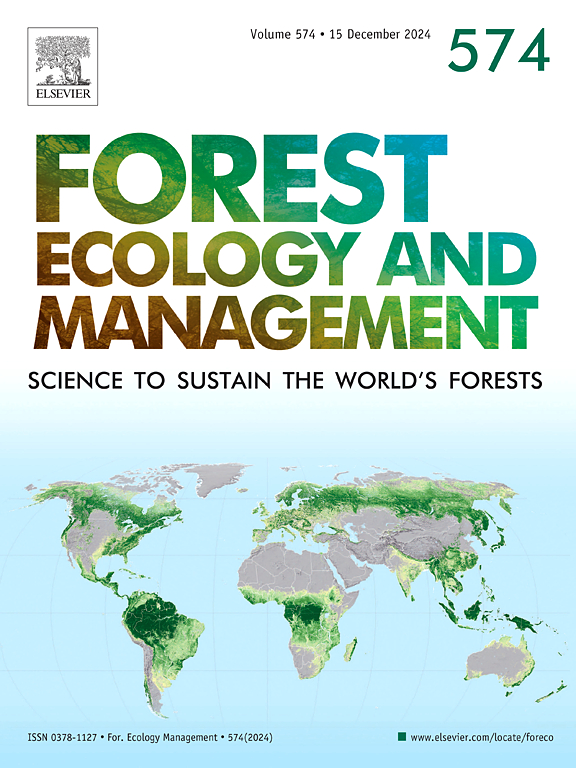Evaluating the potential of oxygen isoscapes for tropical timber tracing
IF 3.7
2区 农林科学
Q1 FORESTRY
引用次数: 0
Abstract
Independent verification of timber origin is needed to enforce legislation aimed at combatting illegal tropical timber trade. A potential technique is tracing back the stable isotope signal preserved in wood samples, but the scarcity of reference data currently hampers its operationalization. This can be overcome by creating isoscapes. Here we develop continental isoscapes (at 0.5° resolution) for five tropical timbers based on wood δ18O ratios and assess their potential for timber tracing. We compiled a pantropical database of δ18O measurements from 712 trees in 20 countries. We tested effects of δ18O in rainfall, potential evapotranspiration (PET), temperature and precipitation on wood δ18O and used these to develop isoscapes based on quantile regression forests. A first indication of the tracing potential of these isoscapes was tested in leave one out cross validation (LOOCV) analyses. Across the five isoscapes, ranges in wood δ18O values (10th-90th percentile) averaged 3.9 ‰ and δ18O differences increased with distance. Yet local variability in wood δ18O was substantial compared to large-scale variability. The LOOCV analysis showed that the actual origin was included in the probable origin for 59–79 % of the cases. The area of probable origin was large, however, suggesting a low spatial precision of assignment. This study finds limited support for a potential to use wood oxygen isoscapes for tropical timber tracing within continents. Necessary future steps in timber isotope tracing include improving regional representation, conducting similar analyses for other isotopes, rigorous testing of species differences and conducting blind sample tests.
评价氧同位素对热带木材示踪的潜力
为了执行旨在打击非法热带木材贸易的立法,需要对木材来源进行独立核查。一种潜在的技术是追溯木材样本中保存的稳定同位素信号,但参考数据的缺乏目前阻碍了其操作。这可以通过创造等高景观来克服。在这里,我们基于木材δ18O比率开发了五种热带木材的大陆等温线(0.5°分辨率),并评估了它们在木材追踪方面的潜力。我们编制了一个来自20个国家的712棵树的δ18O测量数据的泛热带数据库。我们测试了降雨量、潜在蒸散量(PET)、温度和降水中δ18O对木材δ18O的影响,并利用这些数据建立了基于分位数回归森林的等等值图。这些等尺度的追踪潜力的第一个迹象是在留一交叉验证(LOOCV)分析中测试的。在5个等温线上,木材δ18O值(第10 -90百分位)平均为3.9 ‰,δ18O差异随距离增加而增大。然而,与大尺度变异相比,木材δ18O的局部变异是实质性的。LOOCV分析显示,59-79 %病例的可能起源中包含了实际起源。然而,可能的起源面积很大,表明分配的空间精度较低。这项研究发现,利用木材氧等温线在大陆内追踪热带木材的潜力得到了有限的支持。未来木材同位素示踪的必要步骤包括改进区域代表性、对其他同位素进行类似分析、对物种差异进行严格测试以及进行盲样测试。
本文章由计算机程序翻译,如有差异,请以英文原文为准。
求助全文
约1分钟内获得全文
求助全文
来源期刊

Forest Ecology and Management
农林科学-林学
CiteScore
7.50
自引率
10.80%
发文量
665
审稿时长
39 days
期刊介绍:
Forest Ecology and Management publishes scientific articles linking forest ecology with forest management, focusing on the application of biological, ecological and social knowledge to the management and conservation of plantations and natural forests. The scope of the journal includes all forest ecosystems of the world.
A peer-review process ensures the quality and international interest of the manuscripts accepted for publication. The journal encourages communication between scientists in disparate fields who share a common interest in ecology and forest management, bridging the gap between research workers and forest managers.
We encourage submission of papers that will have the strongest interest and value to the Journal''s international readership. Some key features of papers with strong interest include:
1. Clear connections between the ecology and management of forests;
2. Novel ideas or approaches to important challenges in forest ecology and management;
3. Studies that address a population of interest beyond the scale of single research sites, Three key points in the design of forest experiments, Forest Ecology and Management 255 (2008) 2022-2023);
4. Review Articles on timely, important topics. Authors are welcome to contact one of the editors to discuss the suitability of a potential review manuscript.
The Journal encourages proposals for special issues examining important areas of forest ecology and management. Potential guest editors should contact any of the Editors to begin discussions about topics, potential papers, and other details.
 求助内容:
求助内容: 应助结果提醒方式:
应助结果提醒方式:


